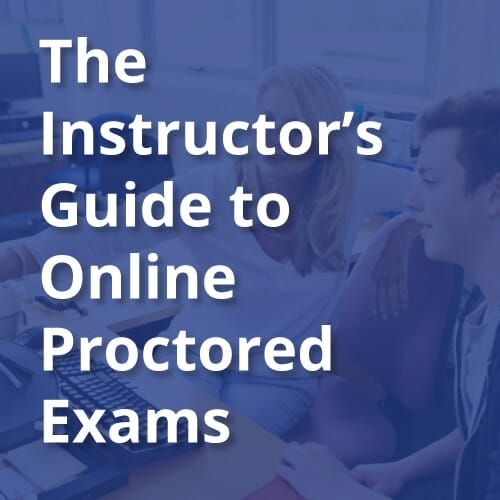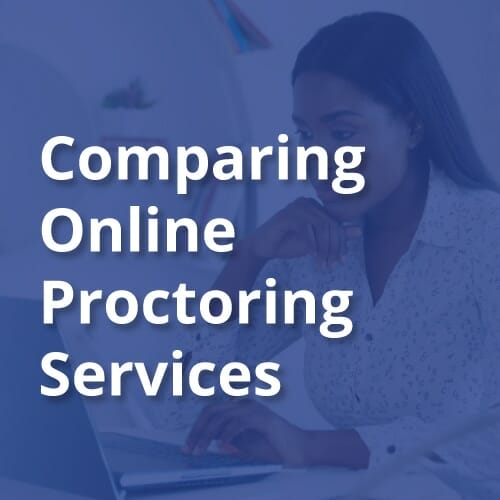Artificial intelligence is everywhere today, and, if you’re like most of the population, you probably have some questions—and even concerns—about it. If you’re an education administrator, you may have even more qualms.
New technology has tremendous potential to improve learning outcomes and student experience – AI in higher education can be a powerful tool to help both faculty and students in and out of the classroom. But, before it’s implemented, it needs to be understood and evaluated.
AI in Higher Education
As online programs continue to expand, there are a number of ways for artificial intelligence to help make the learning experience more integrated. One of the first places you might see it pop up is in virtual proctoring. The good news for you, your faculty, and your students is that it can give everyone a better experience, but, of course, you have questions first.
Let’s jump into some of the things you need to think about when looking at AI solutions to your education challenges.
First Things First: An Open Book
Ultimately, when you start asking questions about the systems you’re considering for online learning and exams, you need information straight from the source. You need a company that is open about their approach, what algorithms they use, how they collect and store data, and how decisions are made.
For instance, if you’re looking at an online proctor that uses any sort of face detection to confirm student identity, you want to know what data it’s collecting and how long it’ll be stored. Having a solid answer will give you peace of mind, and it will help you reassure any concerned students along the way. Your faculty might also have questions about exam content. They’ll want to know that, by using the service, they aren’t signing away the rights to the exams they’ve poured their expertise into creating.
Ultimately, It Comes Down to Rapport
You want to make sure that you are investing in a tech solution provider that has clear answers to all of your questions. Get as specific as you can with your questions, and make sure their answers match up— as they share how they use their algorithms and even software libraries, you’ll become familiar with the process. And, when you get more comfortable with how it works, you’ll start to get excited about everything AI in higher education brings to the table for your program and school.
How Much Can AI Access?
In order to protect academic integrity, many online proctors have a way to detect if a student is trying to access information via another browser or even a secondary device. It’s perfectly understandable that you and your students might be concerned about this. What else can the technology do? Is it accessing other information on the network? How does it tell when other devices are involved without snooping on everyone’s activity? Is it limited, and, if so, how?
This is something you’ll want to be extra sure that your proctoring solution is honest with you about—and that they explain it in a way that is easy for you to then explain to faculty and students when they raise concerns.
How are Decisions Made, and Who’s at the Helm?
When you’re incorporating artificial intelligence into an educational setting, you want just that—a system that is intelligent enough to actually make the process better or easier. But, if you have technology making decisions on your behalf, you want to know exactly what’s involved in that process. Ultimately, you may want to opt for a system that provides a hybrid between the tech and the human touch.
For instance, in a system like Honorlock’s, the AI doesn’t actually make decisions about student behavior. Instead, it flags a potential incident so a live proctor can pop in to assess the situation. The AI flags common problems—like another person entering the room—and gives a rating of low, medium, or high. Then the proctor jumps in to identify what’s happening and can intervene as needed. Based on the proctor’s response and feedback, the system learns and adapts and is able to reduce the number of false positives.
A Hybrid of AI and Human Proctors Sets Students at Ease
At the same time, the human aspect helps set students at ease—they know that the system doesn’t make the final call, so they don’t have to worry as much about accidentally doing something that might raise a flag (like, for instance, moving their face off-camera). And, they don’t have to worry about being watched by a live proctor throughout the entire exam duration.
AI for Scalability
You want to scale your online programs and offer quality education to even more students, and artificial intelligence can help you get there. And, by using a system that learns and adapts to be as accurate as possible when it comes to academic honesty, you can offer the benefits of one-on-one proctoring without the cost for the 99% of times when no one is doing anything wrong.
AI and Student Success
Ultimately, your biggest concern is student outcomes—you want to equip them to succeed, and artificial intelligence helps you do just that. The more laid-back feeling of an AI-monitored exam (as opposed to a live proctor) helps set students at ease and create a seamless, unobtrusive testing experience for those who are doing the right thing. And, for students who are tempted toward dishonesty, the technology makes it hard enough that they often decide it’s no longer worth it—studying becomes the easier option, and they get the benefits of engaging with a quality education.
Use Caution, but Don’t Delay
The adoption of new technology in education can sometimes be slow, and with good reason—it should be tested and understood before it’s implemented, but that shouldn’t stop you from looking into options. You may just find that it makes life better for you, your faculty, and your students. Find a company that will pull the curtain back for you, learn everything you need to in order to implement it, and then jump in with both feet! You and your faculty will love the freedom that the new innovations bring.
Sign up below to receive more resources for tips, best practices, white papers, and industry trends
Want to see Honorlock in action? Schedule a demo.



